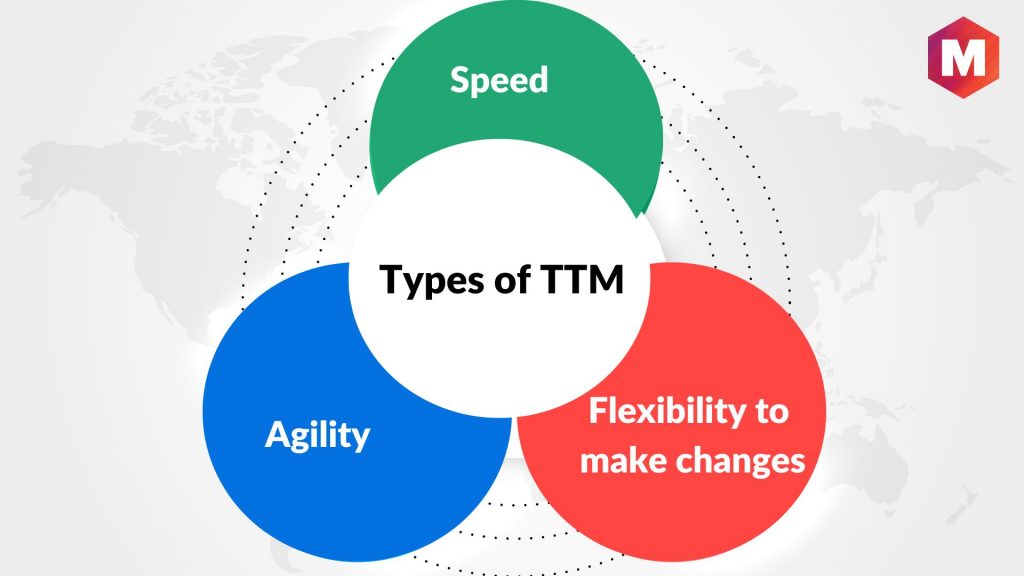Definition: Time to Market (TTM) is the total length of time required to develop a product from its conception to its actual availability in the market. It is a critical measure of success for New Product Development (NPD) and New Product Innovation (NPI) initiatives, as achieving faster TTM can give a company a competitive advantage and position them as a first mover in the market.
Table of Contents
What is Time to Market (TTM)?
The time to market refers to the total length of time it takes for a product, marketing campaign, or operation to move from the initial concept to the finished product. A few common examples of time to market are Coca-Cola launching a new beverage or an automobile manufacturer rolling out its latest car model.
Time to market has become increasingly important in today’s fast-paced world. Companies that can launch their products faster than competitors have a distinct advantage, as they can capture more market share and bring in more revenue.
It is the amount of time that passes from when a company conceives a new product idea until that product is available for purchase by consumers. This timeline involves both the company’s product development process and also the market process. The initial idea must be designed, prototyped, tested, produced, and distributed to the market before consumers can purchase it.
To shorten the time to market, companies must be agile and efficient in their product development process. This can involve streamlining communication between departments, investing in technology to automate processes, and incorporating customer feedback into the product development cycle. Additionally, a company must be able to quickly and accurately predict customer demand and have efficient operations in place to meet that demand.
Why is TTM Important?
A shorter time to market can give a company several advantages. For one, it allows the company to be the first mover in its industry, which can often lead to a first-mover advantage. In addition, it allows the company to take advantage of any windows of opportunity that may exist in the market.
A shorter time to market can also give a company a competitive advantage over its rivals. This is because a company that can bring its product to market faster can respond more quickly to changes in customer demand and trends in the marketplace.
Let’s now have a look at some of the reasons why is time to market important for businesses:
- Revenue increase: The faster you launch your product, the sooner you can start generating revenues from it.
- Competitive advantage: As we mentioned earlier, a shorter time to market can give you a competitive advantage over your rivals.
- Improved customer satisfaction: A faster time to market can meet customer expectations levels as customers are often keen to get their hands on the latest products and services as soon as possible.
- Cost savings: A shorter time to market can also lead to cost savings as a company can avoid the costs associated with maintaining an inventory of outdated products.
- Enhanced brand image: Finally, a faster time to market can also help to enhance your brand image as it can show that your company is innovative and agile.
Types of TTM
| Speed | Time to market can be classified according to the speed with which a product is brought to market. A fast time to market means that a product is brought to market quickly, whereas a slow time to market means that a product takes longer to reach the market. |
|---|---|
| Flexibility to make changes | Time to market can also be classified according to the flexibility that a company has to make changes to its product. A flexible time to market means that a company can make changes to its product without incurring significant delays, whereas an inflexible time to market means that a company would have to incur significant delays if it wanted to make changes to its product. |
| Agility | Agile time to market means that a company can rapidly respond to changes in the market and make changes to its product accordingly. A non-agile time to market means that a company takes longer to respond to changes in the market and is less able to make changes to its product. |
| Predictability | Predictable time to market means that a company can accurately forecast the amount of time it will take to bring a product to market. An unpredictable time to market means that a company is less able to accurately forecast the amount of time it will take to bring a product to market. |
How to Measure Your Time to Market?
Various methods can be used to measure time to market. The most common method is to use calendar days, weeks, months, or years.
Another method is to use the number of steps in the development process. This method is often used by companies that have a very long and complex development process.
Finally, time to market can also be measured in terms of the amount of time that elapses between the decision to develop a product and the actual launch of the product.
The choice of measurement method will depend on the specific circumstances of each company.
Why Reduce TTM?
Reducing time to market can have a positive impact on a company’s bottom line. It can help to reduce costs, improve product quality, enhance brand reputation, and potentially pull ahead of the competition. Additionally, reducing time to market can also help to ensure that products are launched in a timely manner.
Reducing TTM involves optimizing the entire product development. This means ensuring that all stages of the process, from product design and engineering to manufacturing and testing, are as efficient as possible. Additionally, it involves making sure that the development team is properly organized and well-coordinated.
By reducing their time to market, companies can ensure that they remain competitive in the current market and can better respond to changes in customer needs. Therefore, companies need to have a well-defined strategy for reducing time to market. This can involve streamlining processes and procedures, investing in new technologies, and building strong relationships with suppliers.
How to Reduce Time to Market?
There are several ways in which companies can accelerate their time to market.
Using technology
One way of improving time to market is to use technology such as computer-aided design (CAD) and computer-aided manufacturing (CAM) to speed up product development.
Using a minimum viable product (MVP)
Another way to speed up the process is to use a minimum viable product (MVP). An MVP is a version of a product that has the minimum number of features required to be able to test it with customers.
Measuring and evaluating your results
It is important to measure and evaluate the results of your efforts to accelerate TTM. This will help you to identify areas where you can make further improvements.
Refining processes
You should regularly review your processes and refine them where necessary in order to further improve your time to market.
Use automation where possible
Where possible, you should use automation to speed up processes and reduce the need for manual intervention.
Use agile working
Agile working is a method of working that places emphasis on flexibility and collaboration. It can be used to accelerate TTM by making it easier to make changes to products and processes.
Be flexible
You should be flexible in your approach to TTM and be willing to make changes where necessary.
Using proactive risk management
You should proactively manage risks associated with TTM to avoid delays.
Outsourcing
Outsourcing can be used to speed up the process by using external resources to complete tasks that would otherwise be done internally.
Using lean methods
Lean methods such as lean manufacturing and lean six sigma can be used to improve TTM by reducing waste and improving efficiency.
Streamline the development process
By streamlining the process of developing a product, you can reduce TTM effectively. This can be done by simplifying the product development cycle and reducing the number of steps involved.
Use modular design
You can also reduce TTM by using a modular design. Modular design allows different parts of a product to be developed independently and then assembled quickly.
Improve communication and collaboration
Another way to reduce TTM is to improve communication and collaboration. This can be done by using tools such as project management software or chat platforms.
How TTMs Across Companies or Industries Vary?
The typical TTM for a company will vary depending on the size and complexity of the products or services being developed, as well as the industry in which the company operates.
Some industries, such as the automotive industry, have long lead times due to the need to design and test prototypes before mass production can begin. In contrast, other industries, such as the software industry, have shorter lead times as products can be developed and released much more quickly.
As a result, there is no one-size-fits-all answer to the question of what is a typical TTM for a company. However, some general trends can be observed.
In general, larger companies tend to have longer TTMs than smaller companies. This is because they often have more complex products or services and a greater need to coordinate the efforts of multiple departments.
Let’s have a look at the TTM vs Industry table to get a better idea of the time it takes for companies in different industries to bring their products or services to market –
| Industry | TTM Range in Years |
|---|---|
| Consumer Goods | 1 to 5 |
| Semiconductor | 1 to 5 |
| Automobile | 3 to 5 |
| Industrials | 3 to 7 |
| Healthcare and Pharma | 9 to 19 |
| Aerospace and Defense | 3 to 22 |
| Energy | 7 to 23 |
Hence, it can be said that the TTM varies greatly depending on the size and complexity of a product, as well as the industry in which it operates. To reduce TTM, companies should focus on streamlining the approval process, responding promptly to market changes, and ensuring product quality. This would help improve brand reputation while allowing the development team to pull ahead of the competition.
Here is a video by Marketing91 on Time to Market.
Tools and Technologies
- Project management software: Project management software can help to automate the product development process and track the progress of each task.
- aPaaS solutions: aPaaS solutions can help to streamline product development and reduce the time it takes to develop and release new features.
- Risk management tools: Risk management tools can help to identify and assess risks during the development of a product.
- Process flow software: Process flow software can help to visualize the development and identify potential bottlenecks.
What are the Advantages of Reducing TTM?
A shorter TTM can give a company several advantages, including
- Increased market share: A shorter TTM can help a company to increase its market share. This is because a shorter TTM allows a company to get its product to market faster than its competitors.
- Optimized customer satisfaction: A shorter TTM can also help to increase customer satisfaction. This is because a shorter TTM means that customers will receive the product sooner.
- Enhanced revenue: A shorter TTM can also help to increase revenue. This is because a shorter TTM means that products will be sold sooner.
- Reduced costs: A shorter TTM can also help to reduce costs. This is because a shorter TTM means that products will be developed and released faster, which can save on development and release costs.
Conclusion!
Time to market is an important metric for product or software development teams. It can vary considerably depending on the team’s focus and business goals. Product innovation and quality are important factors in reducing TTM. Business opportunities can be lost if a product is not released promptly.
It is the amount of time that passes from when an idea for a new product or service is generated to when it is finally introduced into the market. The shorter the TTM, the better, as it allows a company to get its product out before its competitors, take advantage of market demands, and optimize market opportunities.
FAQs:
How Does Agile Improve Time To Market?
Agile improves TTM by providing a flexible and adaptive approach to product development. Agile focuses on iterative and incremental delivery of value.
How Does a Product Development Strategy Cut Time to Market?
A Product Development Strategy can help to cut TTM by allowing teams to efficiently plan and execute the product development process.
How Does TTM Help with New Product Launches?
Hitting the right TTM can be critical for a successful launch. It allows businesses to take advantage of potential market opportunities before their competitors do. A shorter TTm is a key metric for product or software development teams as it has the potential to affect the success of a business.
How can you improve Time to Market?
To accelerate the time it takes to bring products to market –
- Consider utilizing cutting-edge digital technologies like cloud-based product lifecycle management (PLM) or quality management system (QMS) software.
- Improve your production process by communicating with your supply chain partners in real time and gaining more visibility into issues such as part shortages.
- Reduce your ECO cycles with automated reviews and approvals.
- Merge bills of materials, design files, quality documents, and other significant records into one central source.
Liked this post? Check out the complete series on Marketing



